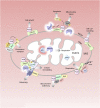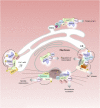Subcellular Organization of the cAMP Signaling Pathway
- PMID: 33334857
- PMCID: PMC7770493
- DOI: 10.1124/pharmrev.120.000086
Subcellular Organization of the cAMP Signaling Pathway
Abstract
The field of cAMP signaling is witnessing exciting developments with the recognition that cAMP is compartmentalized and that spatial regulation of cAMP is critical for faithful signal coding. This realization has changed our understanding of cAMP signaling from a model in which cAMP connects a receptor at the plasma membrane to an intracellular effector in a linear pathway to a model in which cAMP signals propagate within a complex network of alternative branches and the specific functional outcome strictly depends on local regulation of cAMP levels and on selective activation of a limited number of branches within the network. In this review, we cover some of the early studies and summarize more recent evidence supporting the model of compartmentalized cAMP signaling, and we discuss how this knowledge is starting to provide original mechanistic insight into cell physiology and a novel framework for the identification of disease mechanisms that potentially opens new avenues for therapeutic interventions. SIGNIFICANCE STATEMENT: cAMP mediates the intracellular response to multiple hormones and neurotransmitters. Signal fidelity and accurate coordination of a plethora of different cellular functions is achieved via organization of multiprotein signalosomes and cAMP compartmentalization in subcellular nanodomains. Defining the organization and regulation of subcellular cAMP nanocompartments is necessary if we want to understand the complex functional ramifications of pharmacological treatments that target G protein-coupled receptors and for generating a blueprint that can be used to develop precision medicine interventions.
Copyright © 2020 by The Author(s).
Conflict of interest statement
No author has an actual or perceived conflict of interest with the contents of this article.
Figures




Similar articles
-
Compartmentalized cAMP signalling and control of cardiac rhythm.Philos Trans R Soc Lond B Biol Sci. 2023 Jun 19;378(1879):20220172. doi: 10.1098/rstb.2022.0172. Epub 2023 May 1. Philos Trans R Soc Lond B Biol Sci. 2023. PMID: 37122225 Free PMC article. Review.
-
Axelrod Symposium 2019: Phosphoproteomic Analysis of G-Protein-Coupled Pathways.Mol Pharmacol. 2021 May;99(5):383-391. doi: 10.1124/mol.119.118869. Epub 2020 Feb 28. Mol Pharmacol. 2021. PMID: 32111700 Review.
-
Regulation of cardiac function by cAMP nanodomains.Biosci Rep. 2023 Feb 27;43(2):BSR20220953. doi: 10.1042/BSR20220953. Biosci Rep. 2023. PMID: 36749130 Free PMC article. Review.
-
Nanodomain cAMP signaling in cardiac pathophysiology: potential for developing targeted therapeutic interventions.Physiol Rev. 2025 Apr 1;105(2):541-591. doi: 10.1152/physrev.00013.2024. Epub 2024 Aug 8. Physiol Rev. 2025. PMID: 39115424 Free PMC article. Review.
-
Using the Proteomics Toolbox to Resolve Topology and Dynamics of Compartmentalized cAMP Signaling.Int J Mol Sci. 2023 Feb 28;24(5):4667. doi: 10.3390/ijms24054667. Int J Mol Sci. 2023. PMID: 36902098 Free PMC article. Review.
Cited by
-
Regulation of Mitochondrial Homeostasis by sAC-Derived cAMP Pool: Basic and Translational Aspects.Cells. 2021 Feb 22;10(2):473. doi: 10.3390/cells10020473. Cells. 2021. PMID: 33671810 Free PMC article. Review.
-
Phosphodiesterase in heart and vessels: from physiology to diseases.Physiol Rev. 2024 Apr 1;104(2):765-834. doi: 10.1152/physrev.00015.2023. Epub 2023 Nov 16. Physiol Rev. 2024. PMID: 37971403 Free PMC article. Review.
-
The organic cation transporter 2 regulates dopamine D1 receptor signaling at the Golgi apparatus.Elife. 2022 Apr 25;11:e75468. doi: 10.7554/eLife.75468. Elife. 2022. PMID: 35467530 Free PMC article.
-
Comprehensive analysis of transcriptome data and experimental identification show that solute carrier 35 member A2 (SLC35A2) is a prognostic marker of colorectal cancer.Aging (Albany NY). 2023 Oct 26;15(20):11554-11570. doi: 10.18632/aging.205145. Epub 2023 Oct 26. Aging (Albany NY). 2023. PMID: 37889544 Free PMC article.
-
A three-dimensional finite element model of cAMP signals.Forces Mech. 2021 Oct;4:100041. doi: 10.1016/j.finmec.2021.100041. Epub 2021 Sep 4. Forces Mech. 2021. PMID: 35072121 Free PMC article.
References
-
- Abbattiscianni AC, Favia M, Mancini MT, Cardone RA, Guerra L, Monterisi S, Castellani S, Laselva O, Di Sole F, Conese M, et al. (2016) Correctors of mutant CFTR enhance subcortical cAMP-PKA signaling through modulating ezrin phosphorylation and cytoskeleton organization. J Cell Sci 129:1128–1140. - PubMed
-
- Abrenica B, AlShaaban M, Czubryt MP. (2009) The A-kinase anchor protein AKAP121 is a negative regulator of cardiomyocyte hypertrophy. J Mol Cell Cardiol 46:674–681. - PubMed
-
- Adams SR, Harootunian AT, Buechler YJ, Taylor SS, Tsien RY. (1991) Fluorescence ratio imaging of cyclic AMP in single cells. Nature 349:694–697. - PubMed
Publication types
MeSH terms
Substances
Grants and funding
LinkOut - more resources
Full Text Sources
Other Literature Sources

